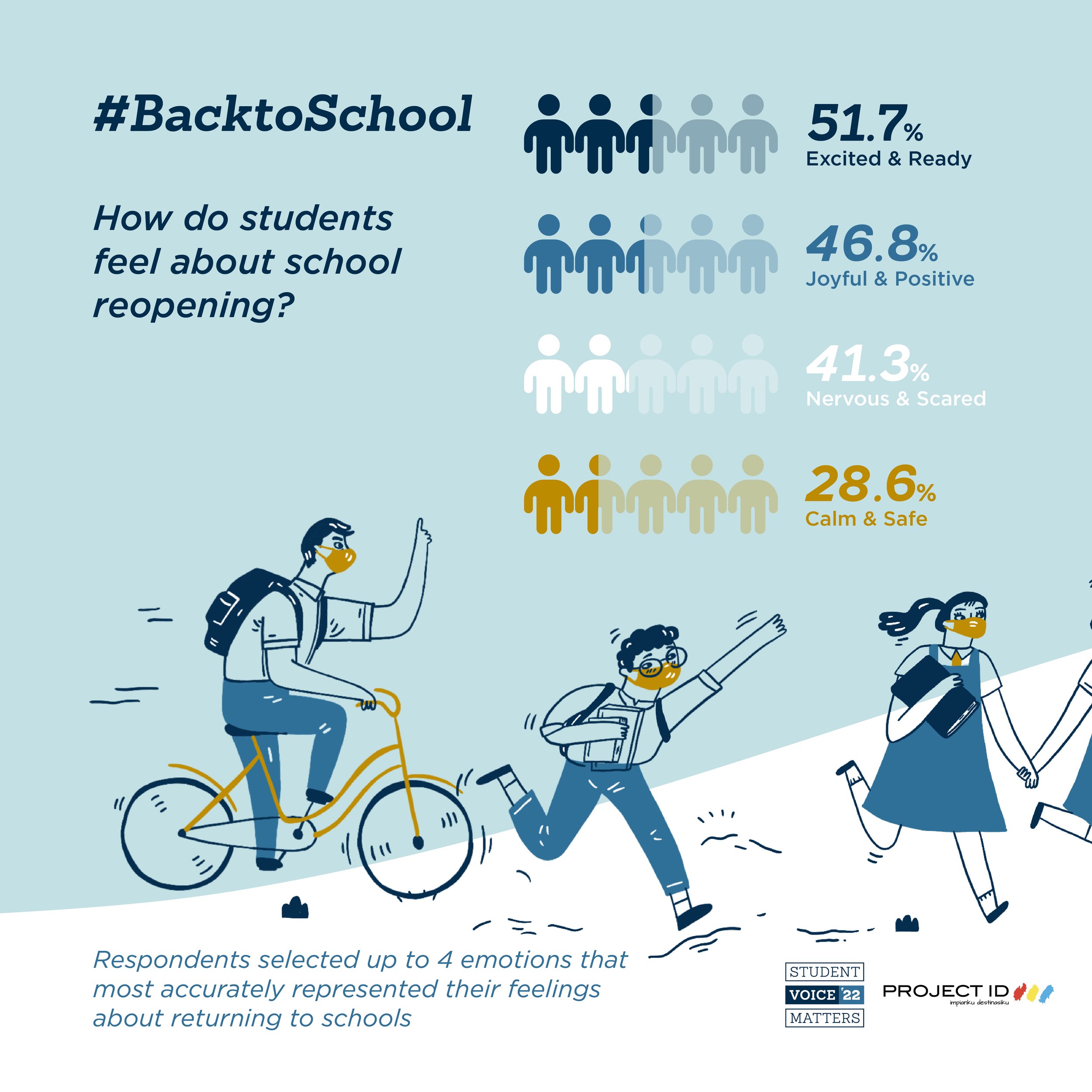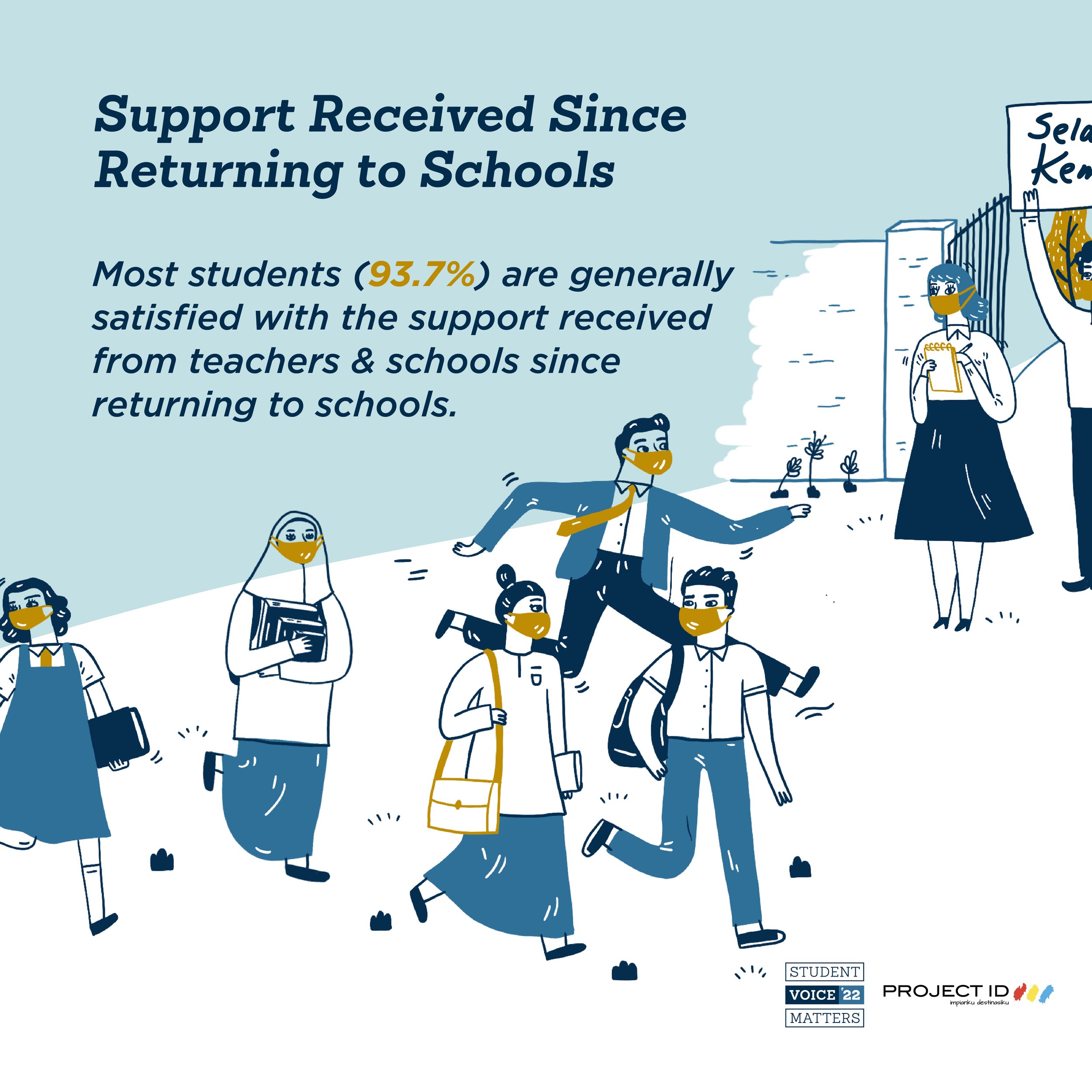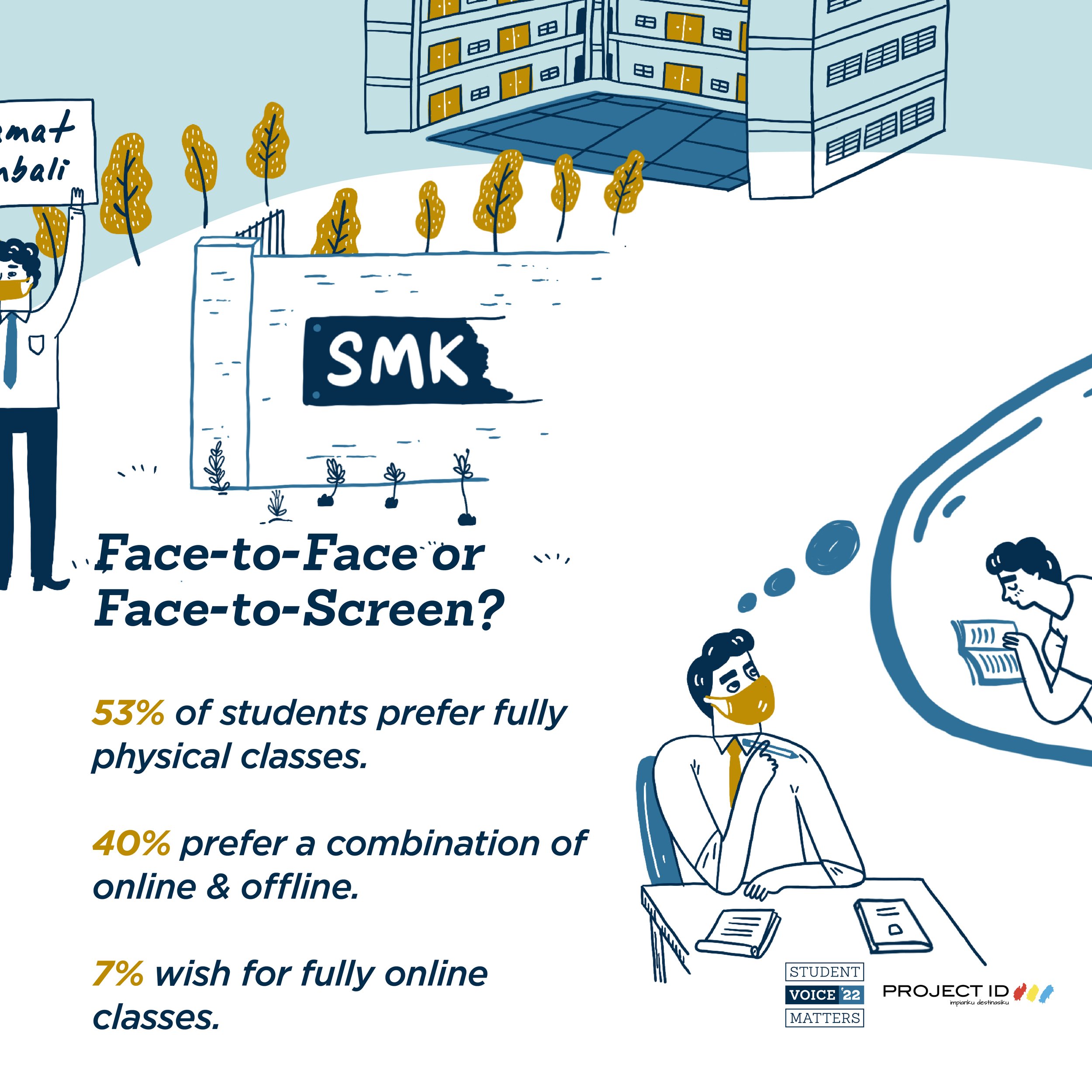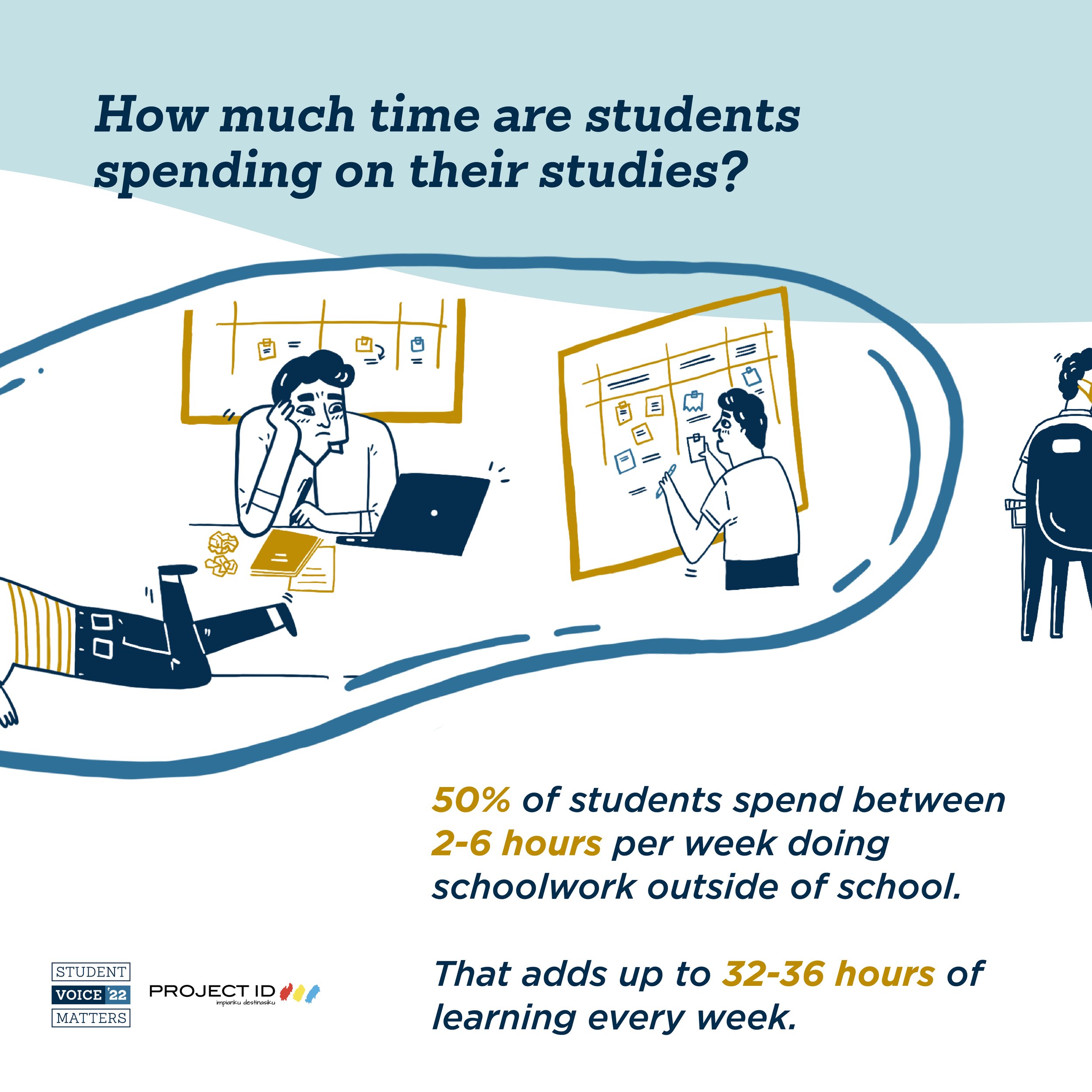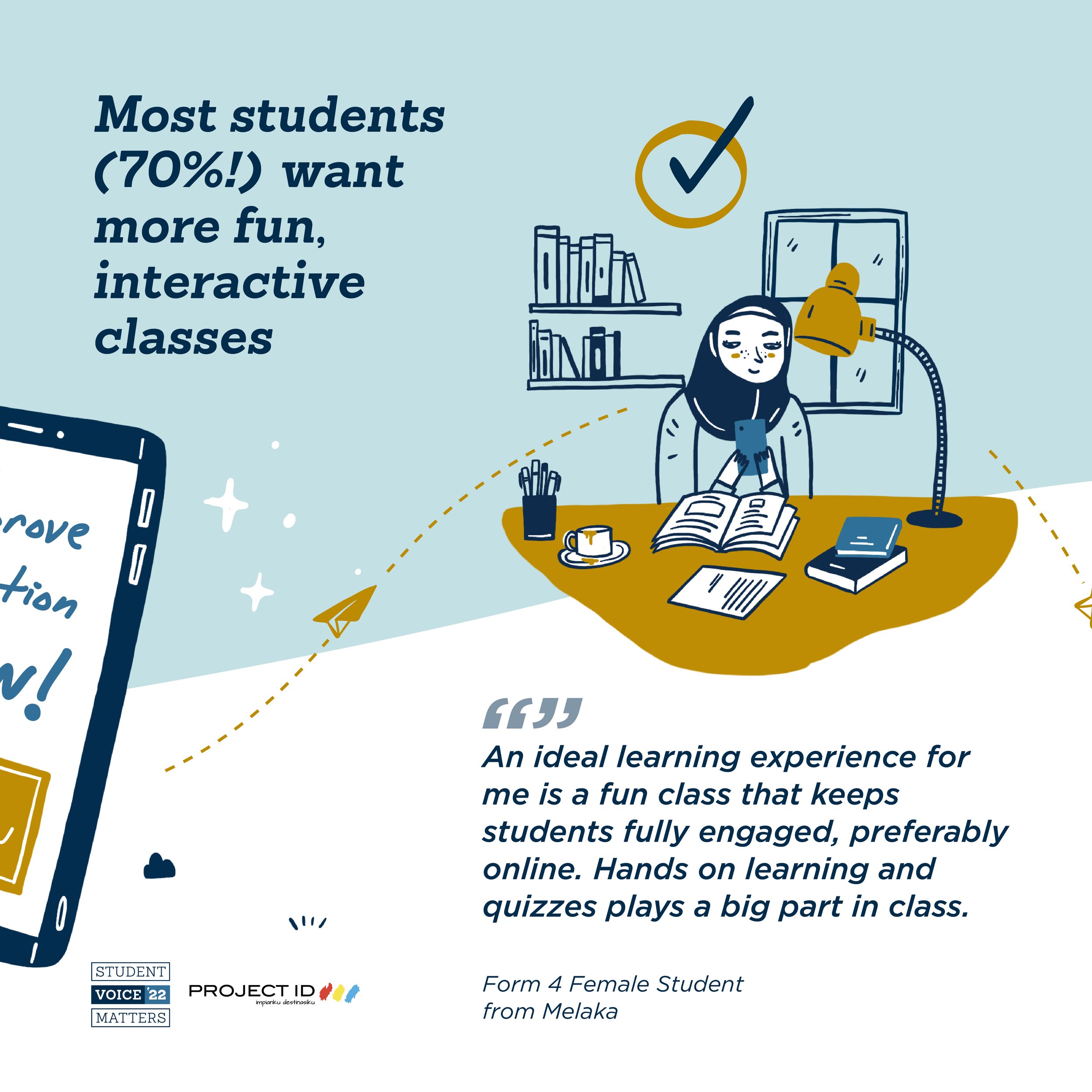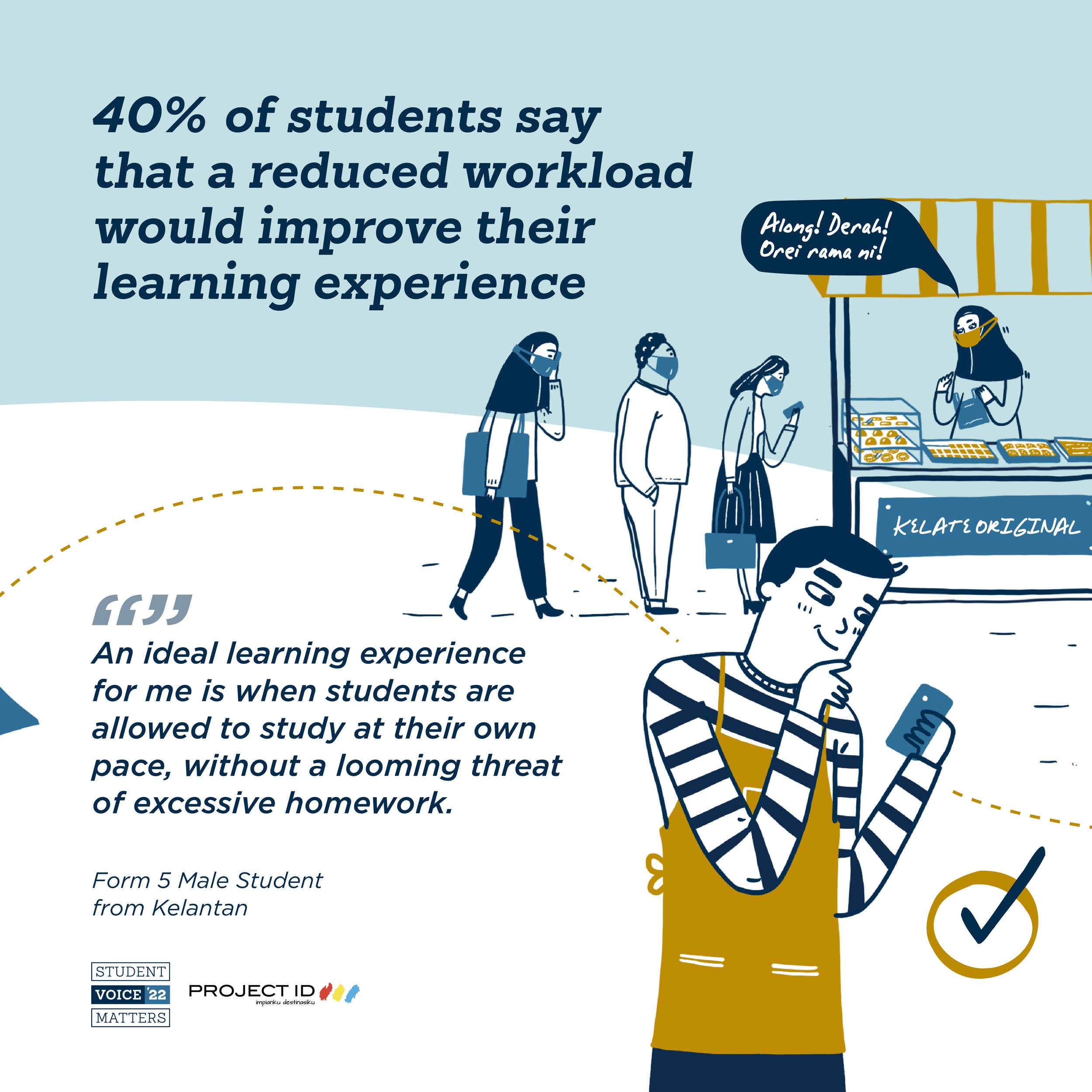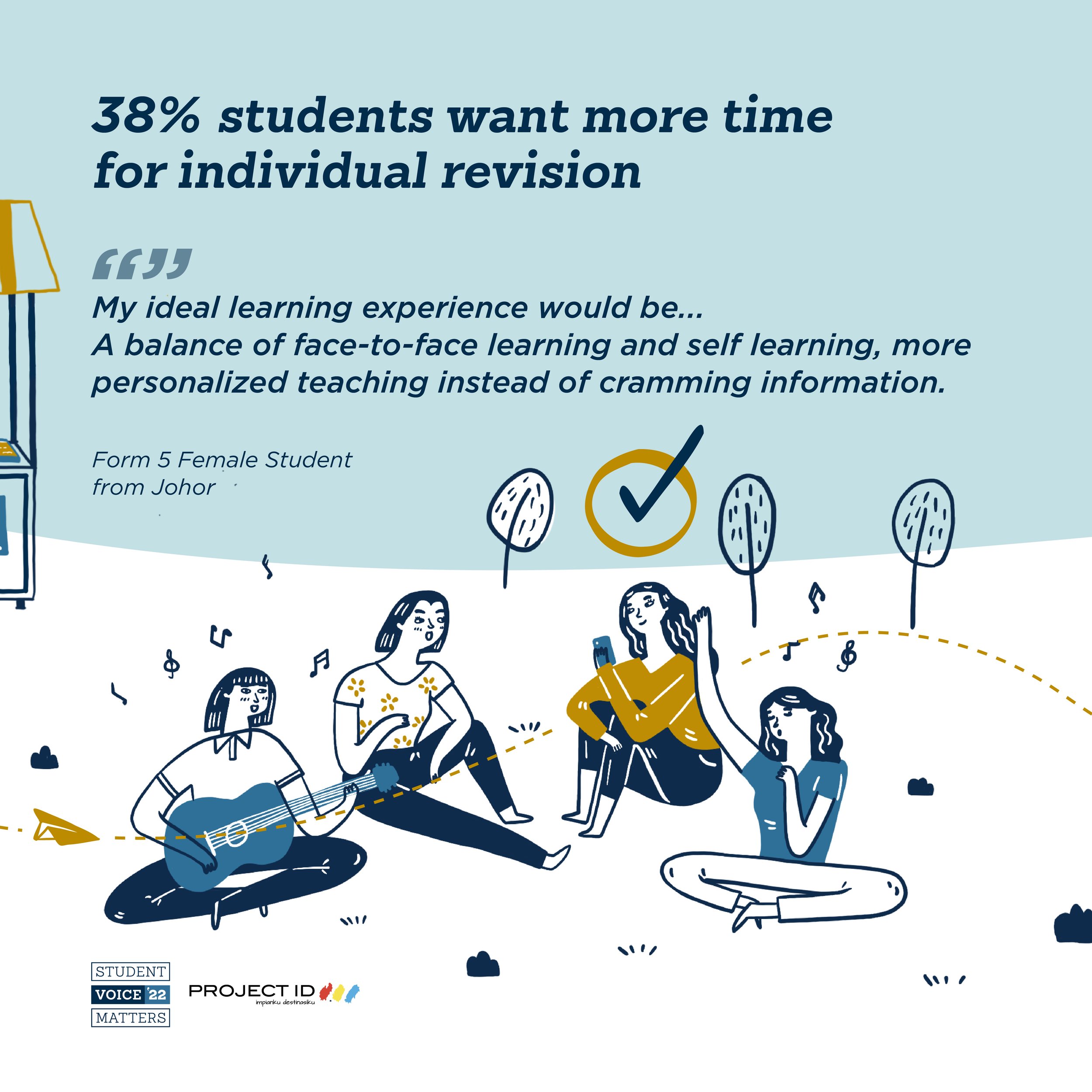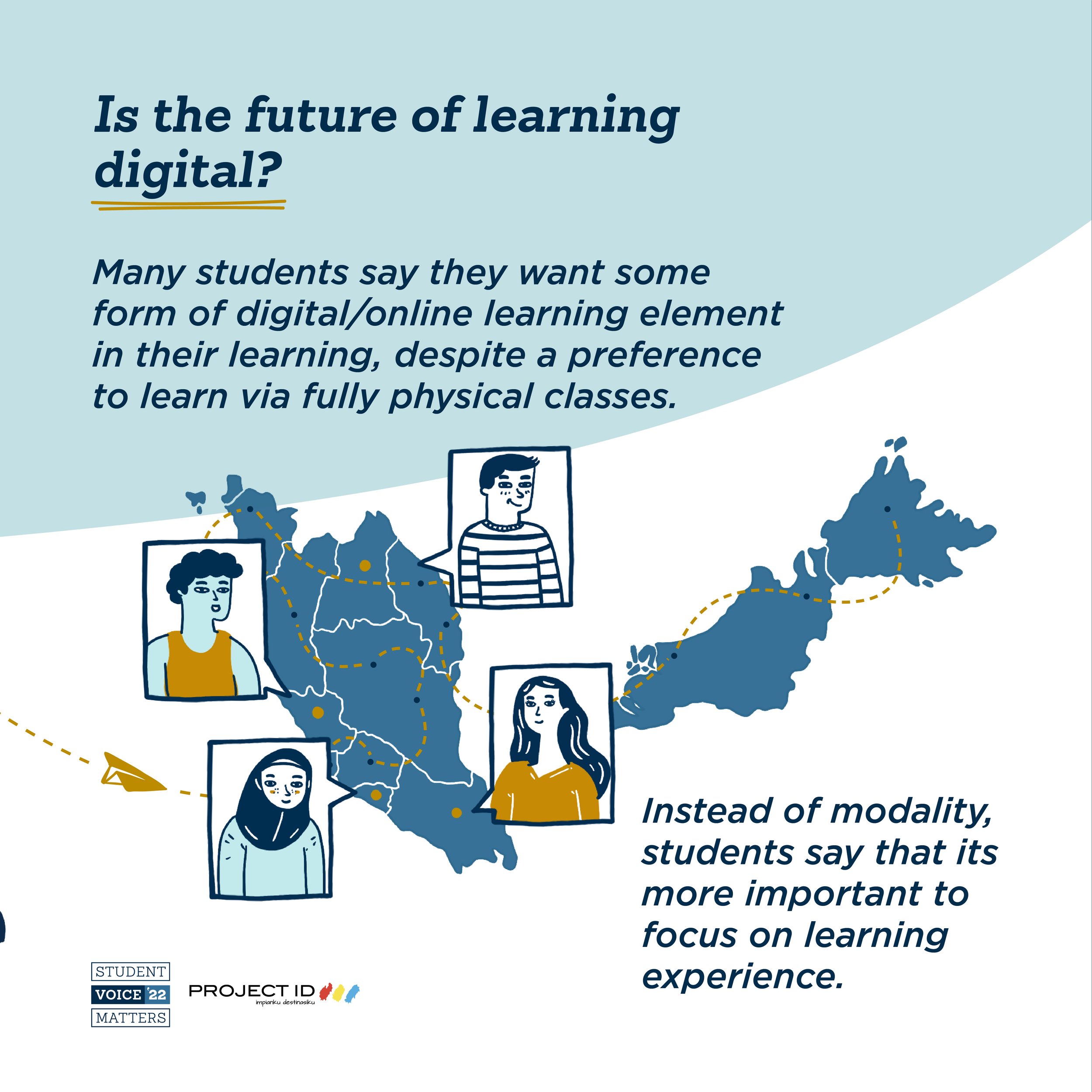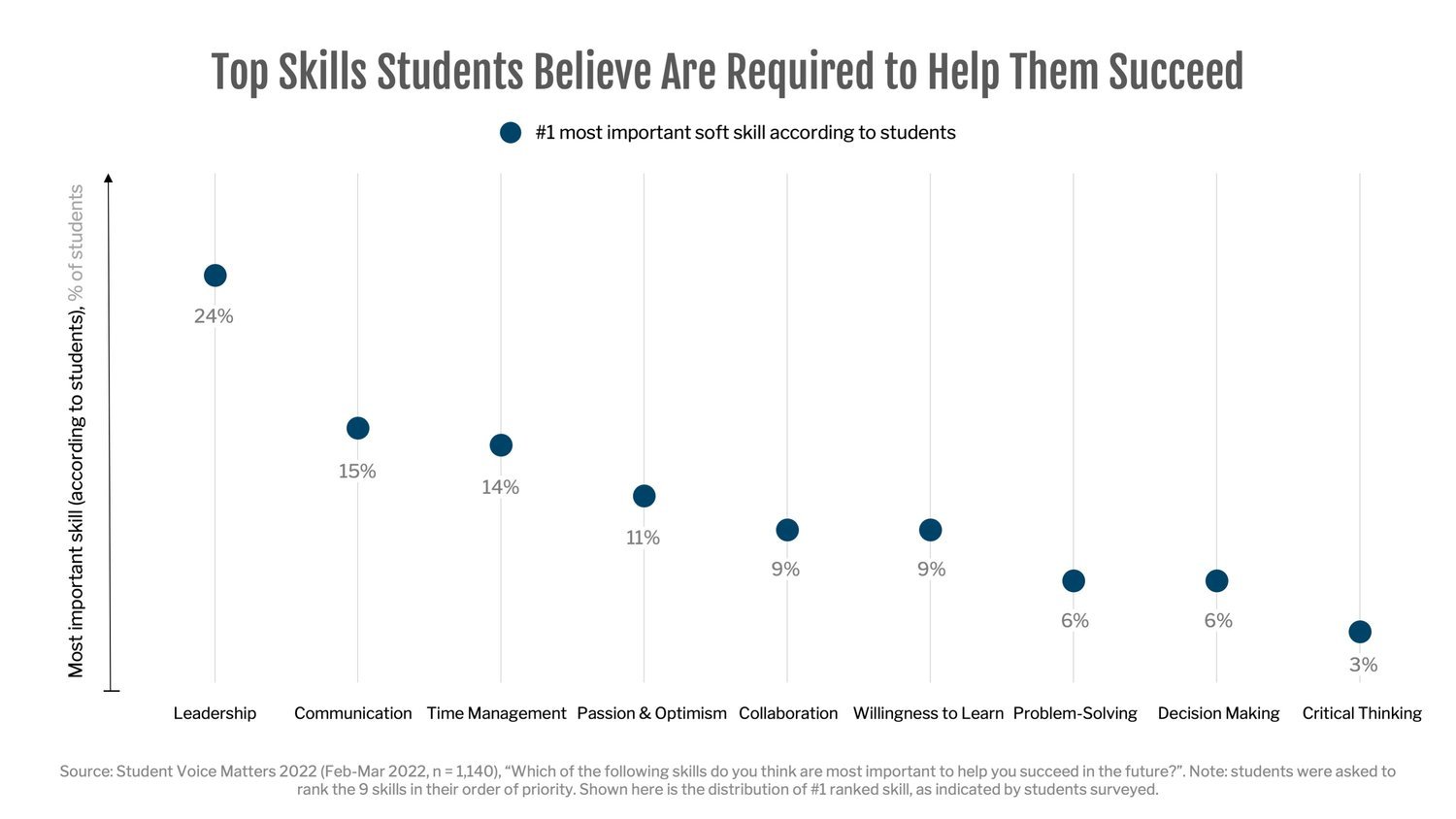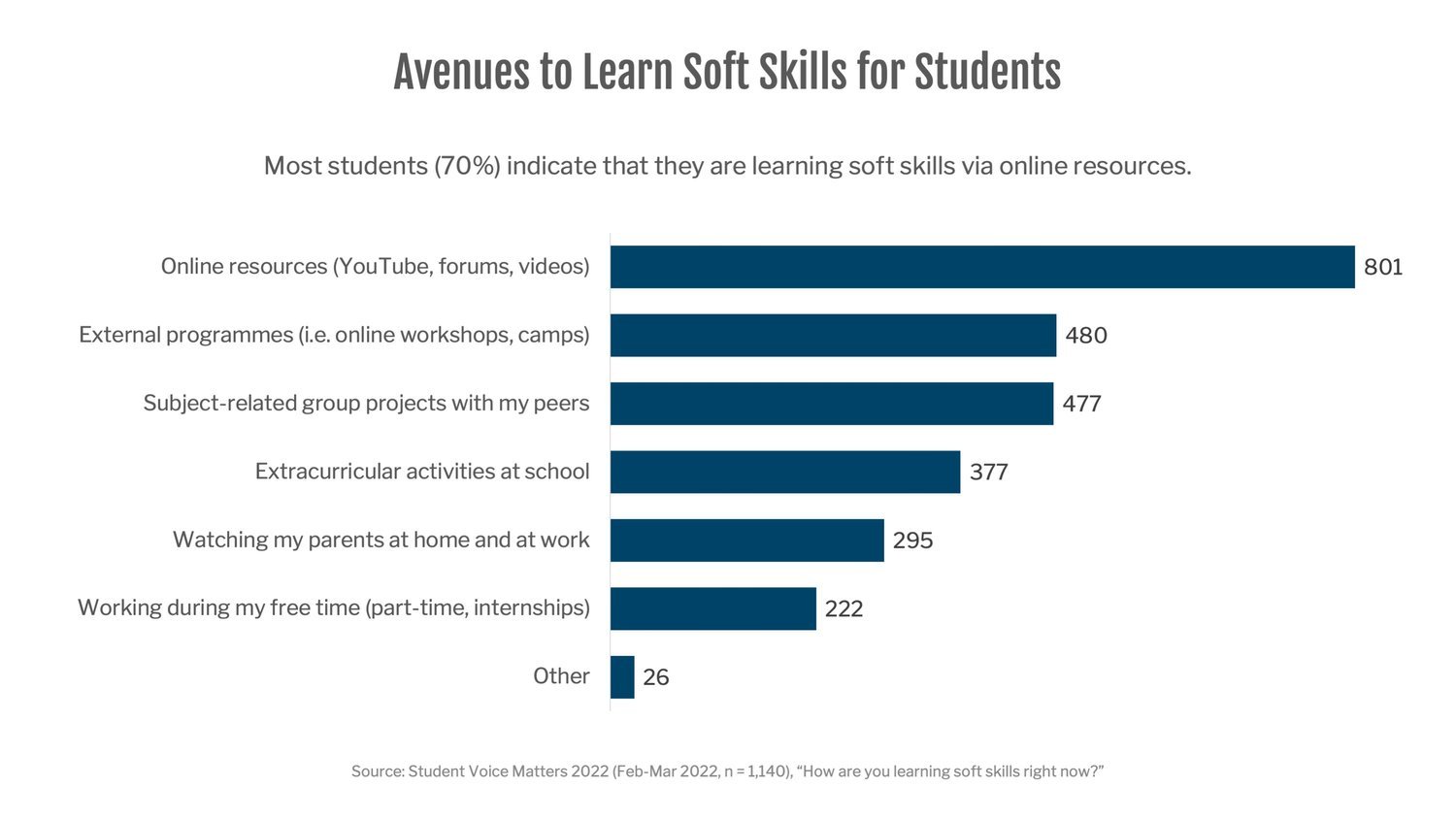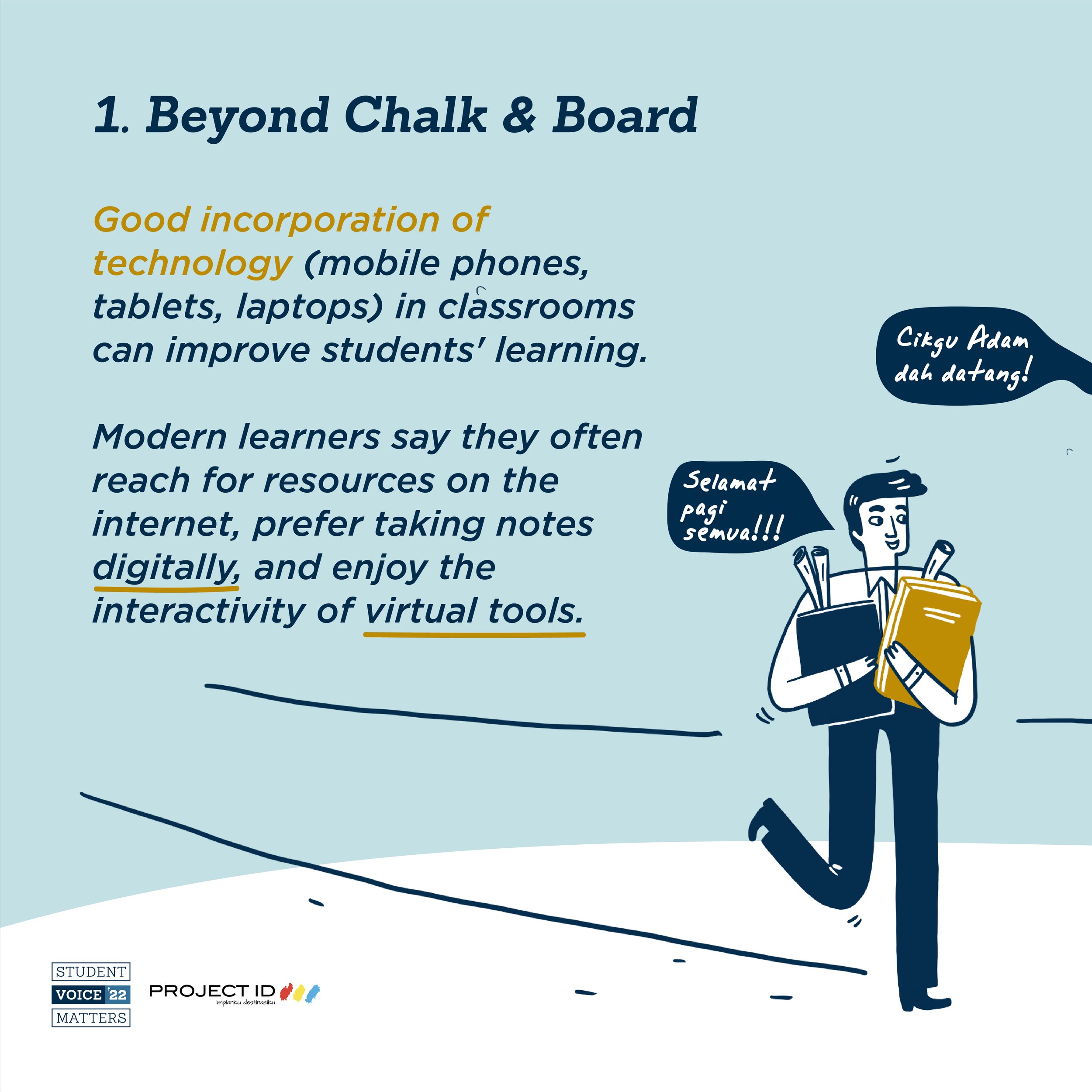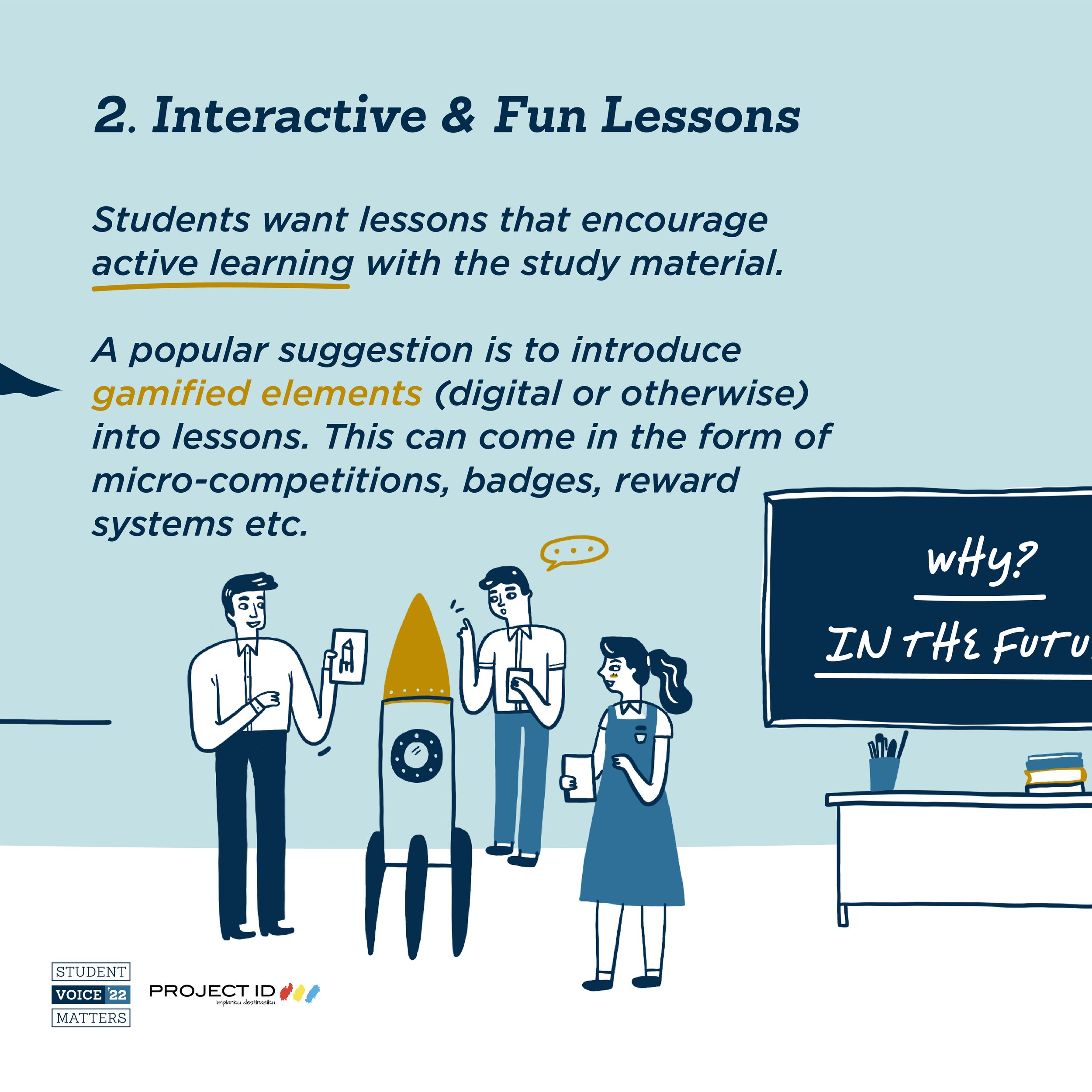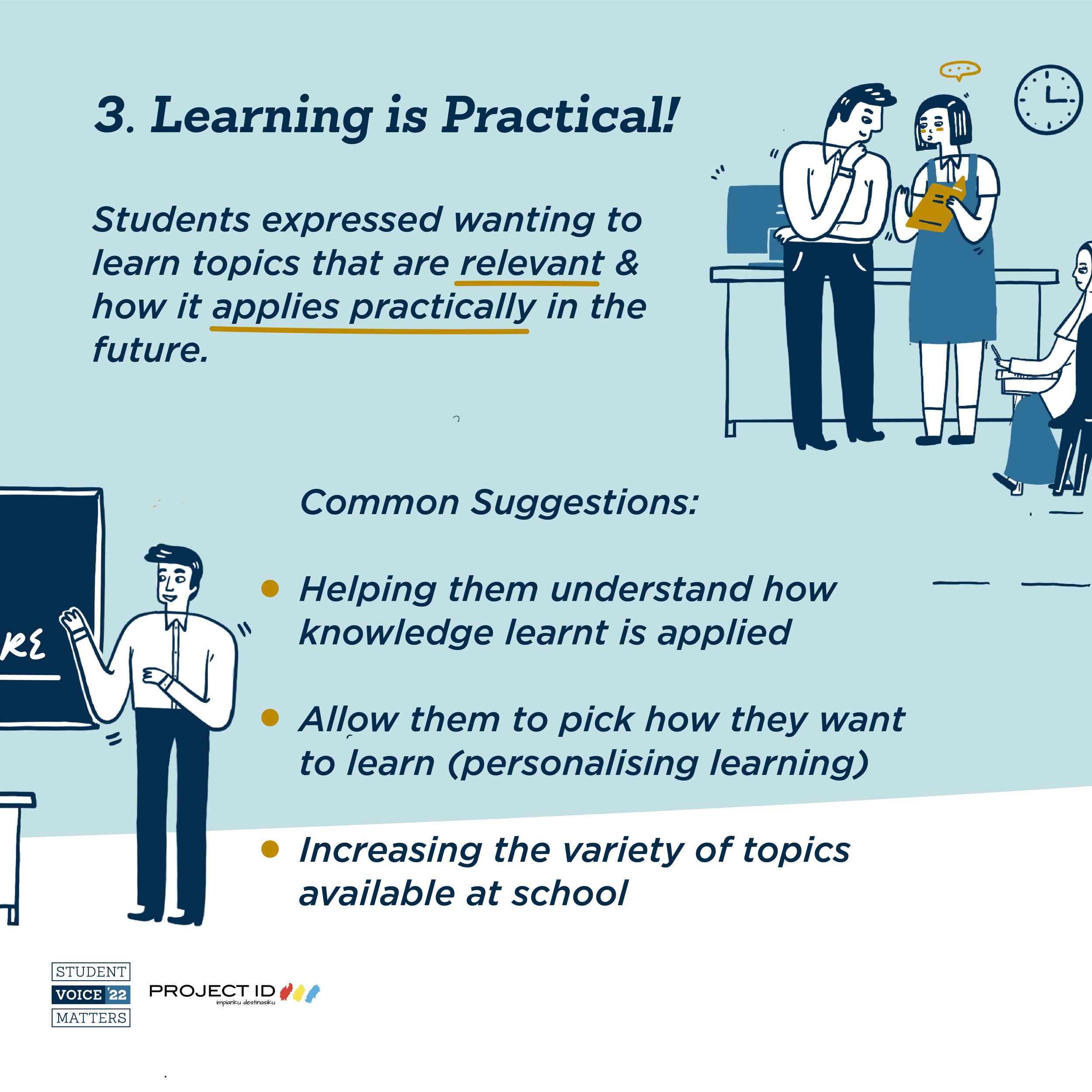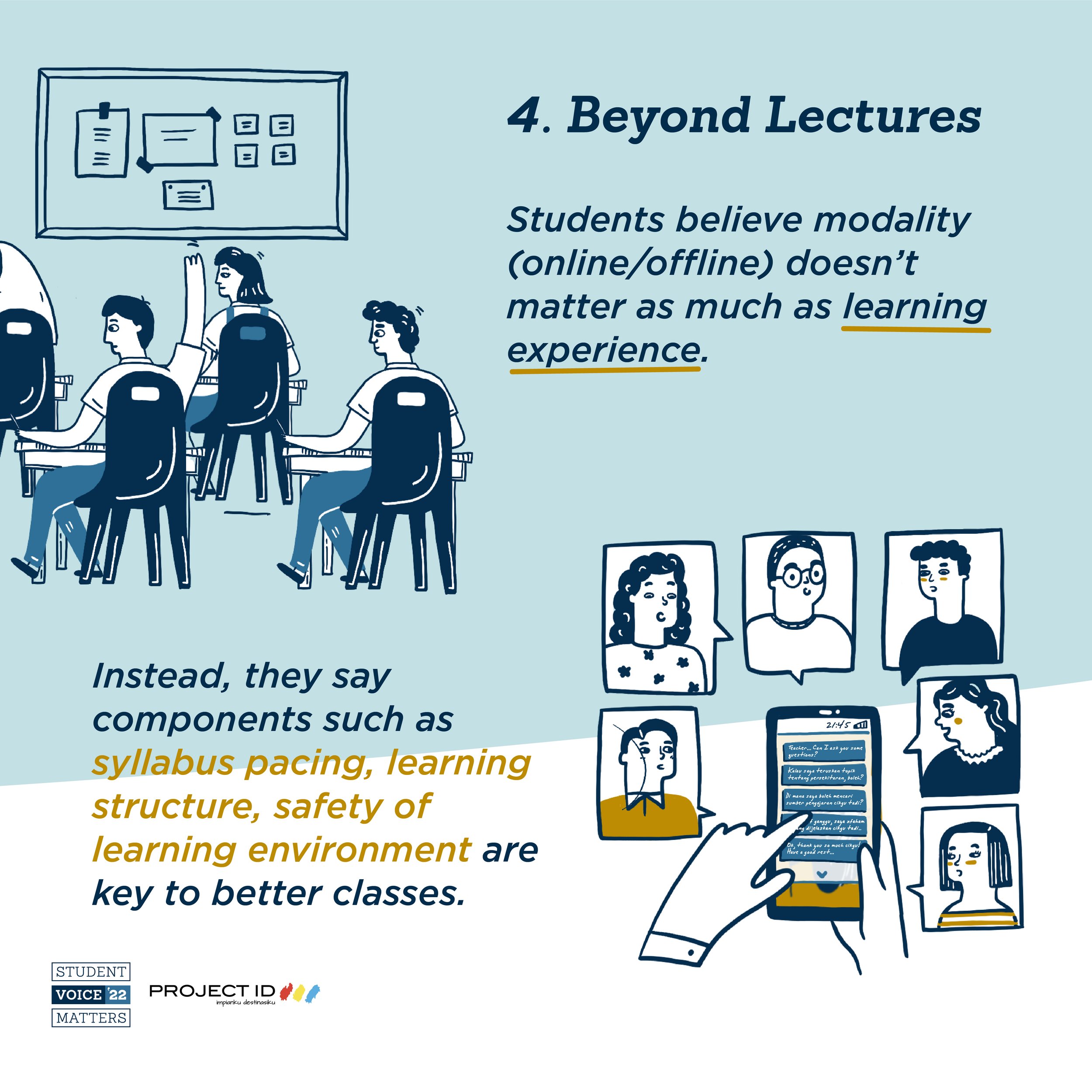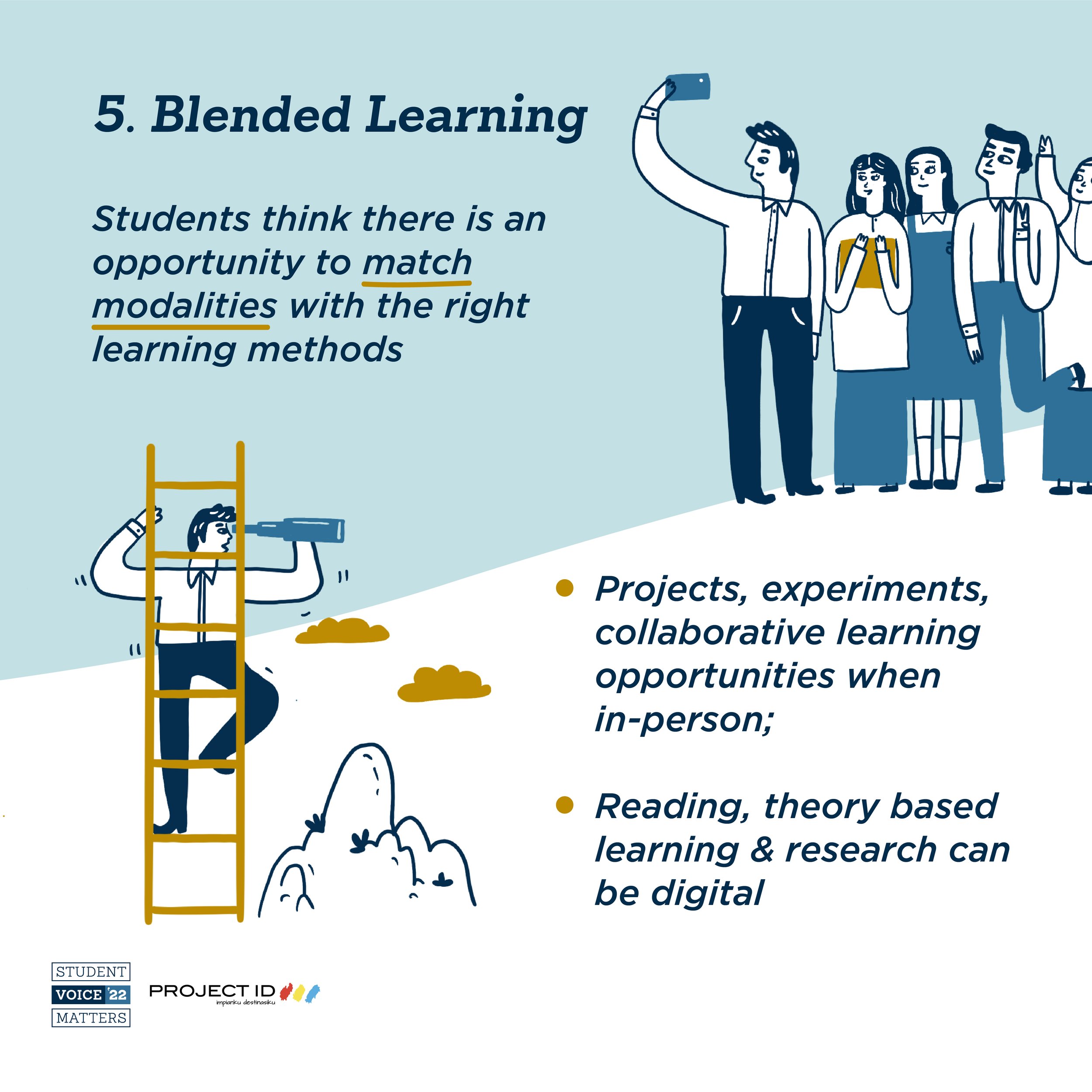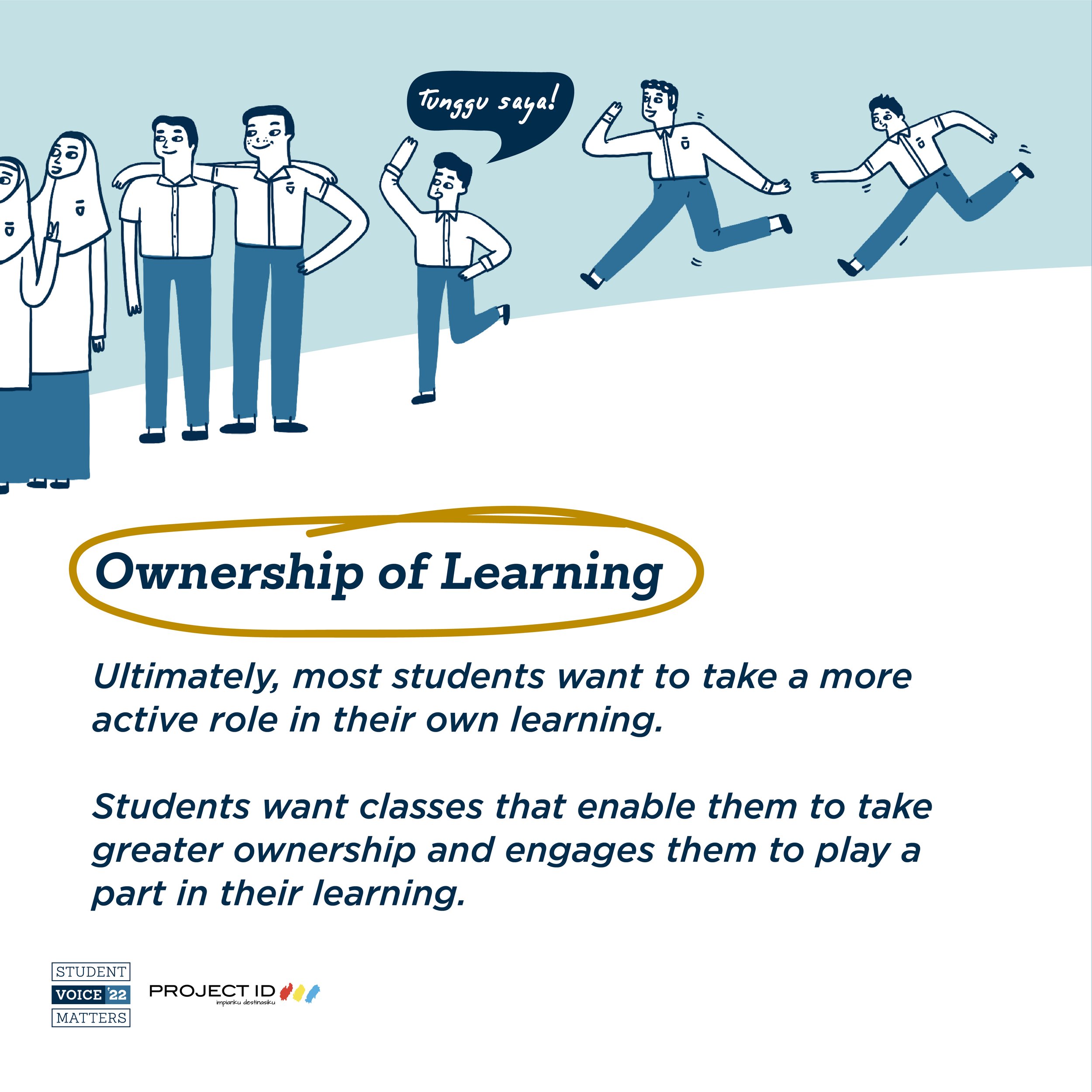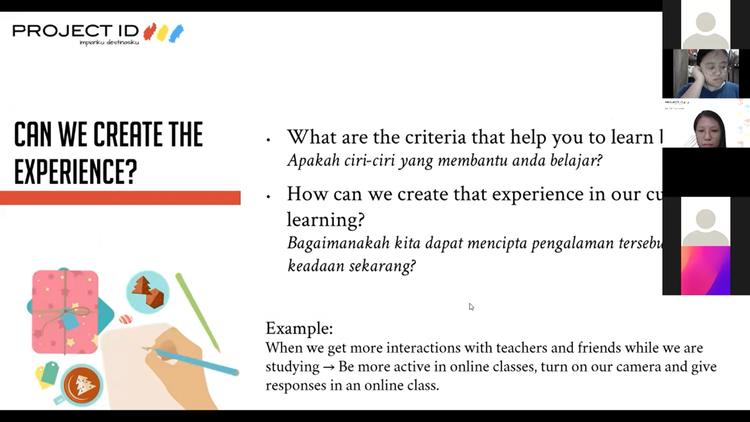What do students say about their learning experience in the past year and beyond 2022?
Student Voice Matters has since evolved into a platform for students to share their opinions on how they want to learn and help shape education in Malaysia. This year, we look into hearing students’ perspectives on three key areas.
Start reading insights by clicking on one of the buttons:
Part I: What does school learning look like in Malaysian education?
This article is the first of a 3-part series from Student Voice Matters 2022.
#BacktoSchool After 2 Years of E-Learning
The COVID-19 pandemic has forced a wave of changes to the manner in which we live, work and study. Speaking to our students and their teachers, we continue to hear stories of the adversities that they have had to overcome as a result of the shift to online learning.
Over the past 24 months, students have grappled with recurring school closures, inconsistent learning structures, disconnect from their peers, and difficulties accessing technology.
Student Voice Matters (SVM) was launched during the pandemic to help us understand what we could do better to help students with their learning. Using insight from previous studies, Project ID conducted over 300 innovative online workshops and camps in leadership, soft skills and career aspirations for over 13,500 students in Malaysia. Central to all these programmes is student involvement in design, planning and delivery.
SVM has since evolved into a platform for students to share their opinions on how they want to learn and help shape education in Malaysia. This year, we set out to understand how students feel about their return to schools, offering their perspective on the current state of learning, lessons learnt from switching back to physical classrooms, and how schools & teachers can continue to support their learning. SVM 2022 heard from over 1,100 Malaysian students.
In this article, we explore what entering physical classes mean for students after 2 years of learning remotely: how they are feeling (health and support received), what they appreciate about in-person classes, and challenges that they face.
How Students Feel About Returning to Schools
“Semasa belajar dalam talian saya berasa kurang motivasi, tetapi semenjak turun ke sekolah saya boleh faham sikit demi sedikit apa yang cikgu mengajar dan berasa gembira kerana boleh berjumpa dengan rakan untuk membuat perbincangan.” - Form 5 student from Sarawak
“(I have enjoyed physical classes)... because it is more understandable than online classes. Plus, I can meet my friends, which makes me more excited to learn.” - Form 2 student from Johor
“Saya berasa gembira kerana dapat kembali ke sekolah. Saya dapat bertanya soalan dengan guru… saya juga tidak perlu duduk di hadapan laptop sepanjang hari.“ - Form 5 student from Penang
Students are generally comfortable with returning to schools, rating their comfort to be 6.75/10 on average. This is consistent across all forms, with Form 1 students (Year 7) rating their comfort most highly (7.8/10). However, as we will see later in this article, some continue to have reservations about safety at schools and/or are nervous about interacting with their peers in-person.
As most schools in Malaysia return to in-person classes, ~45% of respondents indicated positive emotions towards returning to schools, expressing feelings of trust, happiness and anticipation. Other respondents have mixed feelings, with about ~2 in 5 students indicating ‘nervous & scared’ as one of their responses.
Through the survey, we identified 5 factors contributing to how students feel:
Reverting to in-person teaching
Social interaction with peers
Change in student wellbeing through the pandemic
Support received from their teachers & parents
Concerns with schoolwork & exams
Factor #1: In-person teaching
A key highlight that students mention often is the ability to engage their teachers more directly in physical classes and to focus better. Students respond more positively to their learning experience because they no longer have to bridge a digital gap to understand their teachers and ask questions.
“It's much easier and quick… when you have questions you can just ask the teacher or professor in the class. Everything taught in physical [classes] would be much easier to learn.” - Form 5 student from Penang
“…being able to communicate face to face with teachers somehow makes me feel motivated to study. I still struggle with social anxiety and being able to communicate completely but it's definitely better than not being able to speak at all.” - Form 4 student from Johor
“Semasa saya mengikuti kelas dalam talian sukar untuk saya faham dalam sesuatu subjek. Apabila sekolah sudah dibuka, saya berasa lebih faham untuk belajar kerana bersemuka dengan guru” - Form 6 student from Sarawak
This is in contrast to a year ago when students were learning online. In 2021, the struggle was a lack of self-motivation and difficulty communicating with teachers (indicated by 56% and 38% of students respectively).
“The classes were boring and it made it hard to stay focused throughout the whole session.” - Form 4 student from Penang
“For me learning online is really hard since we can’t ask the teacher face to face. Also when we talk about online class of course the internet and surrounding will be the main problem. It really makes me feel down to continue to study.” - Form 4 student from Kuala Lumpur
“I am not motivated to learn. Whenever I have online classes I keep getting distracted by games.” - Form 3 student from Kedah
Factor #2: Social interaction with peers
“Saya ingin bertemu dengan kawan-kawan dan saya rasa saya lebih bertambah motivasi untuk belajar” - Form 4 student from Kedah
“It is because when I learn through online, I tend to get distracted a lot and it did affect me. I also love to revise together with my friends when we are at school so staying at home stop us from doing so”. - Form 4 student from Kuala Lumpur
“Untuk kelas bersemuka pula ia membuatkan saya sangat takut dan gementar untuk bergaul dengan kawan-kawan. Tetapi saya senang faham apa yg cikgu ajar berbanding kelas online.” - Form 2 student from Negeri Sembilan
Through qualitative responses, students highlight the significance of social interaction with their peers. One of the main drivers of excitement upon returning to schools seems to be the ability to meet their friends after a 2 year absence.
Students say that being able to socialise with their peers has led to an increase in their motivation to learn, and returned a sense of camaraderie in learning. Despite that, some students (1 in 5 students) indicate that they experience stress interacting with their peers due to the extended absence of physical interaction.
Factor #3: Changes in student wellbeing
“(because of the pandemic)...I always find myself drained with no rest to catch up on my studies and don't really have the motivation to move forward. It really somehow affected my mental (health).... Thank you for letting us speak our minds, we're finally heard :)” - Form 2 Student from Selangor
“…I just wish teachers could kindly be patient with us.. struggling instead of pushing us to our limits causing us to be all stressed out. I realized that when we're stressed out, we can't get anything done. Mental health matters.” - Form 4 Student from Johor
“...pembelajaran atas talian telah memberi kesan yang buruk terhadap masalah mental… Setelah saya dalam diri saya untuk berjaya dengan mengambil langkah positif seperti membuat rujukan dan latihan tambahan dalam setiap subjek. Saya memberi semangat untuk diri supaya terus berfikiran positif dan jangan sesekali pandang rendah pada diri sendiri.” Form 4 Student from Negeri Sembilan
“Being exposed too much outside can also bring us into contact with COVID. We can go to school for a week and then quarantine for the following week to avoid a rise in cases especially in my class.” - Form 3 student from Perak
Students were asked to consider how their health has changed over the course of the pandemic. Most respondents (80+%) reported either no change or a decline in their mental, physical and emotional health. This is similar to insight from the previous year, where respondents indicated similarly. Health concerns continue to be a worry for students & educationists as students continue to experience the adverse effects of the pandemic.
Students indicate catching up with schoolwork and uncertainties in the school plan to be the top factors contributing to their anxiety and stress. In addition, ~15% of students indicate that financial burden to their family is a factor that they have to consider. Others struggle with a lack of social support (23%), face social anxiety with their peers (22%) and are concerned about their familial relationships (16%).
Factor #4: Support received from parents & teachers
“Guru-guru banyak membantu saya semasa pembelajaran bersemuka. Saya lebih mudah faham dan lebih mudah fokus.” - Form 4 Student from Selangor
“...for SPM as well as my future… I want to make my parents proud, be successful and have a good job…” - Form 5 Student from Selangor
“My teachers tried their best… I am lucky enough to have fairly stable Wi-Fi and don't have to worry about having to share my device with my siblings. But what about other kids that aren't as fortunate as I am?… Not to mention how overworked our teachers are. (I rate my learning experience to be 6/10) because I'm grateful I have no problems for the most part.” - Form 5 Student from Negeri Sembilan
Despite the challenges, most students (~80+%) say that they are satisfied with the support that they have received since schools reopened from their parents, teachers, and schools. Many express empathy & gratitude for their teachers and parents who help them navigate their return to schools. This is consistent with our findings in 2021, where over 90% of students were satisfied with the support they received during school closures (March 2021).
Factor #5: Concerns about schoolwork & exams
“Having trouble catching up after learning through online class. Teachers are moving fast to catch up with the syllabus. Having a hard time gathering motivation to study.” - Form 5 student from Johor
“It is because I sometimes had problems with my Internet, and couldn't listen clearly to the teacher like I could in physical classes. There were also some technical issues, and teachers couldn't share information with us. I also missed out on most of the science experiments, as we couldn't carry out experiments online.” - Form 2 student from Penang
“Saya berasa risau kerana ingin membuat ulang kaji dengan tekun sebagai persediaan untuk ujian semasa buka sekolah. Saya berasa kurang motivasi apabila belajar dalam talian. Prestasi pelajaran saya juga terjejas.” - Form 5 Student from Kelantan
Asked to indicate their stress levels in the given situations, ~56% and 41.7% of students respectively indicate that preparing for exams and catching up with studies resulted in them feeling high levels of anxiety. About 14.3% of respondents were anxious about returning to school, while ~1 in 5 students indicated high anxiety levels at the prospect of continuing online learning.
When asked about their biggest challenges in returning to schools, the top 2 responses were “worries about upcoming exams” and “increased workload to catch up on syllabus”, consistent with their perceived feelings of stress towards exams and studies. Lack of motivation to learn continues to be a challenge for many students, a trend we continue to observe following SVM 2021.
Students still believe in education, despite challenges through the pandemic.
“Learning is meant to be fun, not stressful. In my ideal learning experience, students are encouraged to express themselves rather than follow rules which limit their creativity. Classes can be based on experiments, games and group activities… The education system should focus more on guiding and developing students (to be future ready)...” - Form 4 Student from Pulau Pinang
The recurring school closures and uncertainty has resulted in many students feeling physically & mentally burnt out, which may point to the excitement surrounding their return to school. Despite that, students continue to be hopeful towards their education, responding positively to the statement “I still believe in the value of studying, despite all the challenges I faced during the pandemic”, with over 30% of students rating the statement 10/10 on a Likert-scale.
As we (educators) continue to think how we can support our students through the changing times, we must also weigh the different factors that affect students’ learning experience: social interaction, mental wellbeing, workload, the role of the teacher, situation at home and more.
We know that students have great ideas. To hear what they have to say, we must begin by building real, trusting relationships with them. In the classroom, this can take shape as a simple temperature check at the start of a lesson, in asking for feedback at the end of modules, and even in recruiting students to design shared materials for their classes. By enabling students to participate in the process of learning, we can empower students to be owners of their own education and improve outcomes for them.
YEC 2021 saw 30 innovative lessons from 90 students nationwide.
At Project ID, we do this by heavily involving students in their learning process. We designed the Young Educators Challenge (YEC), a national student competition where students can walk in the shoes of their teachers and compete to design their version of an ideal online classroom, to showcase student creativity. We also collaborated with UNICEF Malaysia to empower young people with skills to maximise their mental & psychosocial wellbeing and be civically engaged in their communities. At all stages, our students were encouraged to co-create and co-lead. They help keep us accountable and our work hyper-relevant to their needs.
As we navigate recovery from the COVID-19 pandemic, there are many lessons that we can learn from the drastic shifts in learning modalities that can help us build back better and future-proof our children’s education. The next article in this series explores how students say they want to learn in the future. It details how digital learning has changed students’ learning habits, which learning methods they enjoy the most, and what support we can offer to improve their learning experience.
Part II: How do students want to learn in Malaysian secondary education?
This article is the second of a 3-part series from Student Voice Matters 2022.
#FutureofLearning: Online or Offline?
In the previous article, we explored what life is like for Malaysian students returning to school in 2022. Here, we share what students told us about their learning experience in the past 12 months, if they prefer learning online or offline, and the type of support they would like moving forward in their classes.
Students have mixed preference toward learning modalities, but most say engaging classes & consistent structure is priority.
“(I prefer to learn via) a mix of online and offline learning, where assignments are given online to be more easily accessible and offline learning to increase interactability.” - Form 6 student from Labuan
“Pembelajaran idaman saya ialah menggunakan buku nota digital dan tidak menggunakan buku teks yang tebal kerana hidup pada zaman yang maju ini kebanyakan pelajar mempunyai akses di internet.” - Form 5 student from Selangor
“I would actually prefer online classes but physical classes really help me a lot to study. My learning sources on the Internet help me a lot. I can actually understand it properly when the teacher is teaching since there's a lot of new words on the internet that I have never heard of.” - Form 4 student from Johor
“I would choose both with a balanced schedule. This is because I have access to the internet in online learning thus increasing the gain of information and technological knowledge which I just discovered during online class while offline class helps my studies and focus on learning.” - Form 4 student from Negeri Sembilan
When asked about their preference for learning modalities (online or offline), 53% of respondents indicated that they prefer fully physical classes. Despite returning to schools, many students (47%) continue to express that they want some element of digital/ online learning in their curriculum. Similar to our findings in 2021, students express appreciation for the flexibility, accessibility, and engagement that digital learning methods (software & the internet) continue to offer over traditional in-person classrooms. Many also suggest that the addition of digital devices & tools such as digital notes & slideshows in the classroom may elevate their physical class experience.
“In my opinion, the ideal learning experience is where lectures give student a clear goal in each class to make sure that they do not feel lost in search of meaning to attend a class, and provide the student with homework just enough for them to finish and not to much for them to feel bored and likely to drop the work. Plus, let the student use the internet as a way to find information for the topic that they learned, or provide a simple basic phone to use in each class.” - Form 6 student from Sabah
“(I want to learn) in a fun and energetic environment with enough motivation and hope to study… understanding and sporting type of teachers that don’t rush through the syllabus… I also prefer learning through the internet, group projects and (enjoy classes with) fun activities to do.” - Form 5 student from Johor
“I would prefer a pinch of everything that has interactions… and use gadgets (devices) throughout classes as it is way simpler… WiFi should also be provided if gadgets are to be used.” - Form 5 student from Kedah
“(Pembelajaran saya boleh ditingkatkan)... dengan pembelajaran dalam talian seperti membuat quiz ataupun pertandingan dalam talian.” - Form 2 student from Sarawak
Students continue to indicate that more fun, interactive classes and a clear & consistent learning structure as their top priorities to improve their learning experiences. This is consistent with 2021, where the majority of respondents indicated the same. Previously, we focused on helping teachers improve their online classes. However, as both teachers and students return to the physical classroom, students say that group projects, digital engagement tools, and gamified learning activities can help.
Students indicate a slight improvement in their learning experience in the past 12 months
“Returning to school was not bad as there’s less work given and I could discuss with friends. However, I do feel a little anxious about some subjects as we couldn’t complete the form 4 syllabus before going to form 5.” - Form 5 student from Kuala Lumpur
“Saya berasa selesa apabila belajar secara talian kerana saya tidak lagi mengalami kesukaran untuk berhadapan dengan rakan-rakan sekolah serta saya lebih gemar menanyakan soalan kepada cikgu melalui atas talian.” - Form 3 student from Selangor
“It was great to learn online but it was hard to catch up with subjects such as maths and add maths as it requires detailed teaching. It was also hard to cope when we were suddenly required to have face to face learning as most learning sheets are in laptops and ipads that need to be printed.” - Form 5 student from Kedah
“Fokus saya terhadap pembelajaran sejak wujudnya COVID-19 semakin merosot dan agak sukar untuk memahami sesuatu mata pelajaran ketika kelas secara dalam talian kerana menggunakan format SPM yang baharu pada tahun pertama.” - Form 5 student from Sarawak
On average, our students indicate that their learning experience in the past 12 months to be 5.84 / 10 (± 0.06). This is a slight improvement to the previous year, where students scored their learning experience on average to be 5.42 / 10. In article #1, we identified some potential factors that contribute to this such as the return to in-person teaching and increased social interaction with their peers.
Similar to SVM 2021, Form 5 students rate their learning experience to be lowest across all forms. They are also more likely to indicate that catching up with schoolwork contributes to their stress.
Students’ learning habits have changed to be more digitally-inclined
“I (used to be) more comfortable learning with hardcopy books but nowadays I gravitate more to online materials that are free to use. Even while preparing for SPM, I studied more using notes from the Internet as revision books tend to be costly. Besides books, videos and interactive websites can give clearer and much in depth explanations especially for subjects that require you to understand visuals and diagrams.” - Form 6 student from Selangor
"I would like to study in groups with my peers while having access to seniors' aid and online sources. This way, my peers and I can exchange opinions and brainstorm on questions together, but still have someone or other ways to help in solving the problems we encounter while self-learning." - Form 5 student from Pulau Pinang
“(I prefer digital learning because)... I can learn from anywhere. (There are also)... many online platforms that can facilitate my studies better” - Form 5 student from Kedah
When asked about how the pandemic has affected their learning habits, ~58% of students respectively say that they now rely more on digital learning platforms to revise & learn while ~52% prefer to revise individually because of the access to resources on the internet. This is consistent with qualitative responses to the survey, where some students express how they continue to appreciate access to online materials on platforms such as YouTube, Telegram and Discord.
Student rank lectures, individual revision and collaborative classes to be their preferred learning methods
“I also believe student-and-teacher interaction is important especially for students who will be facing examinations and need support through face-to-face classes. Students can focus better in class too” - Form 6 student from Selangor
“I would prefer for teachers to give lectures about a certain topic and then provide notes and worksheets via online for us. Following that, we should be given opportunities for group studies and individual learning.” - Form 5 student from Johor
Lectures rank most highly in students ranking of preferred learning methods, scoring an average placement of #3.11, followed by individual revision (#3.77) and collaborative classes (#3.80).
Students ranked lectures as their most preferred learning method (#3.11), followed by individual revisions (#3.77) and collaborative classes (#3.80). Despite many students calling for hands-on learning experiences in qualitative responses, project-based classes scored lowest of the options.
Across learning methods, the majority of students preferred learning in offline environments (with respondents indicating lecture-style classes being most preferred for an online modality).
Students indicate leadership, communication and time management to be the most important skills to help them succeed
Saya lebih gemar melakukan aktiviti yang melibatkan bergerak atau bercakap… Aktiviti seperti ini dapat meningkatkan keyakinan pelajar untuk bertutur secara lantang dan jelas di hadapan kelas... - Form 4 student from Pulau Pinang
“The application of online learning together with physical classes also opened a lot of opportunities that I couldn't have gotten from physical learning (online competitions, tech skills enhancing, and many more)” - Form 4 student from Melaka
~1 in 4 students indicated leadership to be the most important skill to succeed in life, followed by communication & time management. This correlates to top in-demand skills required for the modern workplace as reported in research by leading employers.
When asked how they were learning soft skills, most students (70%) indicated online resources to be their main source of information, followed by external programmes such as online workshops & camps. Extracurricular activities at school ranks as the 4th most popular avenue. ~1 in 5 students also indicate that they work during their free time (part-time, internships).
Rethinking ‘digital’ in classrooms.
As we recover from the pandemic, we continue to consider how we can leverage on digital/ online tools adopted during the school closures to improve learning experiences. While students indicate preference for fully physical (53%), many note the importance of digital elements in their classes moving forward.
Screenshot from a PID Online workshop by Project ID in collaboration with SKRINE on communication techniques utilising creative elements of digital learning and professional facilitation techniques.
We observe an increasing preference for digital tools when learning asynchronously, where many students indicate reliance on resources on the internet as a means to revise (53%) and other online learning platforms to learn (58%). Despite only 7% of students preferring fully online classes, students show an inclination to learn online for methods such as lectures (40%) and individual revision (37%).
We also observe a call for adoption of digital tools in the physical class. Students point to tools such as slides, gamified quizzes, and digital badges as activities that can help improve their engagement and motivation. Some students (38%) also say they prefer to take notes and complete their worksheets digitally, while enjoying the presence of their peers & teachers in-person.
Rather than simply returning to pre-COVID classrooms, this presents us with an opportunity to rethink the way we are integrating technology in our classrooms and the role the teachers must play to facilitate learning for a new generation of digitally native learners. Globally, teachers are redesigning their lessons with “googling in mind” and finding new ways to engage their students. Leaning on the student voice, we can reshape teaching to match how students want to learn.
In article #3, we explore considerations for how we can design more engaging, inclusive and learner-centric classrooms post-COVID from what students tell us about their version of an ideal class.
Part III: What makes a good learning experience? (From Students' Perspective)
This article is the third and final part of a series from Student Voice Matters 2022.
In the previous SVM 2022 articles, we shared insights on how students feel about returning to schools and what they want for their learning post-pandemic.
Using what students shared with us about their education, we identified 5 factors that teachers, parents & institutions can consider for an improved student learning experience post-COVID:
Technology in classrooms
‘Fun factor’ of classes
Learning structure & experience
Student ownership of learning
Matching method to modality
#1 Technology in learning
Compilation of learning apps students mentioned to help them learn from the survey
“I wish to bring our phone, tablets and laptop to school, so we can search for information when we are unclear.” - Form 4 student from Selangor
“Let the student use the internet as a way to find information for the topic that they learned, or provide a simple basic phone to use in each class.” - Form 6 student from Sabah
As we saw in the previous article on how students want to learn, student preference for digital tools have increased as a result of the pandemic. Students’ habits are more digitally-inclined, and many call for greater incorporation of technology in their classrooms. Students appreciate the accessibility of resources online and think digital platforms can increase the number of engagement options. Separately, many students also express preference to take notes digitally.
In addition to incorporating lessons learnt from our use of technology during school closures, there is an opportunity to innovate and increase the number of ways we use digital platforms for learning even as students return to school. One example is the surge in digital learning mobile applications.
Learning apps have grown in popularity amongst students for its accessibility and flexibility. Students enjoy the digestible content which can be in the form of quizzes, videos, and learning games. Students also mention how they are actively utilising online video platforms as an independent learning resource (447 mentions of Youtube in SVM) to learn topics at their own pace and in the comfort of their home.
#2 Fun & engaging lessons
“Dalam talian kami boleh membuat quiz online supaya lebih menarik minat kami untuk belajar manakala belajar secara fizikal bagi kami lebih jelas dan faham perkara yang kami kurang faham.” - Form 3 student from Perak
“Saya lebih gemar untuk belajar dengan cara berinteraksi dengan rakan-rakan seperti jalankan aktiviti treasure hunt kerana cara ini boleh memberikan kita pengetahuan dengan seronok yang menyebabkan kita lebih tertarik dalam pembelajaran ini.” - Form 3 student from Perak
“Pengalaman saya ialah ketika belajar dalam sesuatu subjek ,guru perlu menyediakan kuiz atau permainan yang berkenaan dengan pelajaran ketika belajar agar semua pelajar merasakan keseronokan untuk belajar.” - Form 5 student from Johor 4
More fun, interactive classes continue to be the top response from students when asked about how their learning can be supported. Students say that classes that encourage them to learn actively through gamified elements (quizzes, mini-competitions, educational games) and interactive content (digital engagement, group learning activities) can help increase their engagement and motivation in classes.
Developing engaging lessons can take up considerable effort and time. From Project ID’s experience, there is an opportunity for educators to make lessons fun and interactive without having to redesign lesson plans. Teachers can shift focus from directing learning for the classroom to co-leading the learning process with students. In fact, students tell us that they want to take an active role in leading their learning.
Photo of an online chemistry lesson presented by a finalist team during YEC 2021.
One of the examples of how we apply this co-leading learning concept is via the Young Educators Challenge (YEC). In YEC, students underwent various workshops in lesson planning and facilitation skills to craft their own online lessons. By enabling students to express their creativity in designing their own online lessons, they are empowered to take ownership, drive innovations in teaching pedagogy, and share solutions to improving the learning experience.
#3 Learning structure & experience
“The ideal learning experience is where lectures give students a clear goal in each class to make sure that they do not feel lost in search of meaning to attend a class.” - Form 6 student from Sabah
“With a structured environment, it provides a clearer mind and allows for planning ahead of what must be done when both in and out of school.” - Form 2 student from Penang
“My ideal learning experience would be a highly structured one. One which has everything needed to be learnt for the semester planned out for specific dates. All dates for projects, exams and any other possible important activities scheduled.” - Form 2 student from Penang
Regardless of modality, many students continue to share that they value a clear & consistent learning structure and feel more comfortable when teachers create safe spaces for them to learn and ask questions.
In some cases, students also mention the importance of highlighting the relevance of the topics they are studying (why & how the topics apply to real life), lessons that are appropriately paced, and carefully moderated workloads (homework, reading).
#4 Student ownership of learning
“Pembelajaran idaman saya ialah duduk secara berkumpulan dimana dalam kumpulan memiliki pelajar yang mempunyai kemahiran dalam subjek yang berbeza. Dengan ini pelajar dapat saling membantu dalam meningkatkan prestasi mereka” - Form 4 student from Sarawak
“Provide the student with homework just enough for them to finish and not too much for them to feel bored and likely to drop the work.” Form 6 student from Sabah
“I hope there are more group works which can improve my communication skills and leadership.” - Form 4 student from Johor
Through qualitative responses, many students express that they want to have stronger ownership to their own education. Students often ask to be involved in decision-making processes in their classes (what topics they learn, how & when they learn it).
Some students also ask for resources to prepare before classes - indicating a desire to pre-read and increase the depth of their learning.
Many studies have indicated that student autonomy in learning leads to improvements in both academic and non-academic abilities (such as life-skills). The National Center on Scaling up Effective Schools found that developing ownership to learning has proven to give students a stronger sense of self-efficacy and are able to deeply engage in learning activities. According to the same study, students who own their learning are more invested in their schooling and demonstrate life-skills such as initiative, self-direction, and resilience.
#5 Matching method to modality
“Physical class is best because you can meet your friends face-to-face and can make your homework together and can help in each other to understand subject that hard for you.” - Form 6 Student from Johor
“Online classes help me to focus better. Physical classes are more suitable to carry out activities such as experiments” - Form 3 Student from Melaka
“Kombinasi kedua-dua pembelajaran (kelas fizikal/atas talian) ini akan mendorong kepada pembaharuan dan menarik minat pelajar terutamanya dalam fasa teknologi yang berkembang pesat.” - Form 4 Student from Selangor
While students generally indicate a preference for fully physical classes, a significant number of students indicate that they prefer a combination of both online & offline learning methods.
We have observed students and educators experimenting with various learning techniques over the past two years. Despite the return to physical classes, the post-pandemic learning environment has evolved from the traditional classroom. One realisation that surfaced is that learning can occur anywhere at anytime, remote or physical. Ultimately, what matters most to students is the learning experience, with the best fit-for-purpose modality.
As we continue to try and build greater resilience into education post-pandemic, there is an opportunity to configure the modern classroom to fit the needs of particular learning methods i.e. teachers can focus on hands-on experiences such as projects, experiments, and collaborative learning opportunities when in-person, while reserving lectures, reading & theory-based classes for when remote.
Conclusion - Education in 2022 & beyond
Student Voice Matters 2022 was set out to understand how students feel about returning to school, how they want to learn post-pandemic and how teachers, parents & institutions can provide for an improved student learning experience.
Student ownership and flexibility in learning remain to be the current sentiment found across our insights. Student participation in their own education is important because it invests them in their own learning, and can meaningfully inform teaching deliveries, school systems, and policymaking.
Photo from a reflection session during a PID Online 2021 workshop.
At Project ID, we strive to create safe spaces for students to learn and venture.
In elevating the student voice, Project ID turns to our annual Student Voice Matters survey which collects diverse student perspectives to inform us in empowering Malaysian students. From student-centric national competitions to hosting mini-internships for Form 4 students (16 year-olds), we have run over 300 free online workshops in helping students develop the soft skills that will help them succeed in the digital economy(i.e. leadership, communication and collaboration).
The changes brought about by the COVID-19 pandemic present an opportunity for educators and institutions to design better learning experiences for our students by integrating lessons learnt in digital tools and compassionate teaching to the physical classroom.
“Our hope is that SVM continues to inspire parents, teachers and schools to listen to our students, and help create classes that are learner-centric. ”
Interested to Learn More?
Student Voice Matters (SVM) is a study designed to help educators, parents & institutions gain insight into what students in Malaysia want for their education.
The study is unique because it leverages on the students’ voice to inform educational policy and decision-making.





